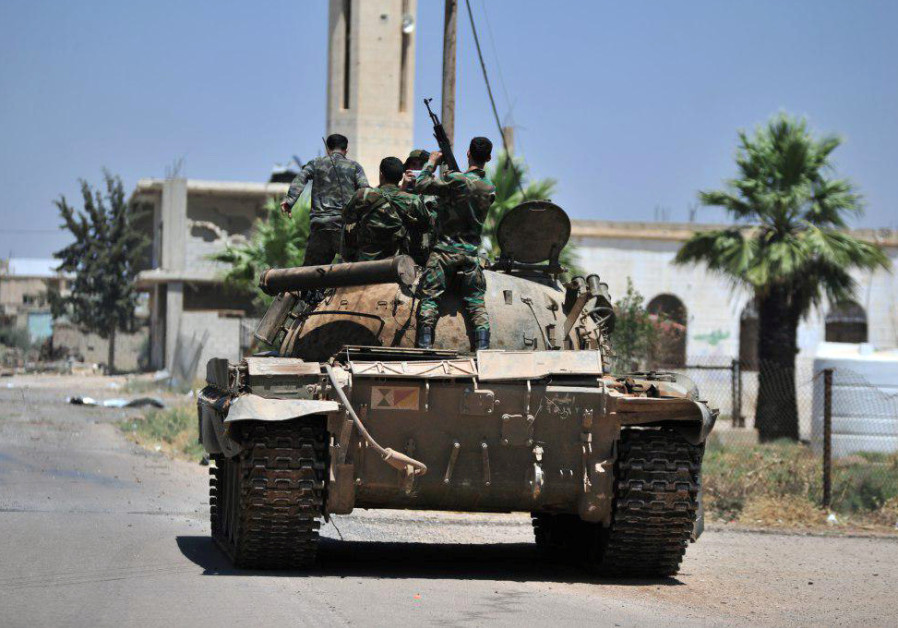Syrian rebel towns accept Assad rule following heavy bombardment

Forces loyal to Syria’s President Bashar al-Assad are deployed in al-Ghariya al-Gharbiya in Deraa province, Syria in this handout released on June 30, 2018. (photo credit: SANA/HANDOUT VIA REUTERS)
A string of Syrian rebel-held towns and villages accepted government rule on Saturday, after intense bombardment this week that the UN said caused 160,000 people to flee, including to the Israeli and Jordanian borders.
Neither country is willing to accept the refugees as insurgent lines collapse in parts of the southwest as the result of a Syrian regime offensive against rebel forces, backed by Russian air power that began in mid-June.
Syrian rebels reported and posted a photo of Syrian regime air strikes near the town of Nawa on Saturday, which is five kilometers from al-Rafeed on the border. Still, sounds of fighting, such as the “boom” of air strikes, could be heard from the Golan.
The government’s offensive so far has focused on Dera’a province, which borders Jordan, but not Quneitra province abutting the Golan Heights. The regime and Russian warplanes have avoided air strikes near the Golan, so that it has become a temporary safe haven for the refugees on the Syrian side.
The refugees think that setting up tents in the cease-fire area will protect them from encroachment or attack by the Syrian regime.
On Saturday, the tents, buses and shacks of the refugees could be seen for several kilometers stretching from the Syrian village of al-Rafeed toward al-Malgah in the southern Golan, around 20 km. south of Majdal Shams.
Some of the tents appeared to be new and orange, while others looked dusty and may have been near the border for longer.
The displaced people have gathered as close as possible to Israel’s security fence that runs along the border and many of them are between the 1974 cease-fire line Bravo and line Alpha in an area usually patrolled by the United Nations Disengagement Observer Force. An UNDOF deployment map from last year shows that the displaced people have gathered next to several UNDOF observation points.
The presence of thousands of Syrians near the border will increase pressure on Israel to do more than supply humanitarian aid. Many of the Syrian rebel groups along the Golan have developed quiet relations with Israel over the years, according to reports, and the civilians think that they will be safe near the border.
“We’re closely monitoring what is happening in southern Syria,” Defense Minister Avigdor Liberman said on Twitter on Friday.
“We’re meticulous in safeguarding the State of Israel’s security interests,” Liberman said.
“As always, we’re prepared to provide any humanitarian assistance to civilians, including women and children. But we will not accept any Syrian refugees in our territory,” Liberman said.
As part of that assistance the IDF transferred six wounded Syrians, including four young children, to Israeli hospitals for treatment Saturday.
On Thursday night, the IDF said it delivered 300 tents and almost 50 tons of humanitarian aid across the border.
In a video posted Friday some of the internally displaced persons called on Israel to protect them and for the UN to return in force to their patrolling areas along the border.
The Syrian army has already captured large parts of the eastern zone of rebel-held territory in the region less than two weeks into its offensive.
In eastern parts of Dera’a, the army took control of al-Ghariya al-Sharqiya and al-Ghariya al-Gharbiya and Um Walad, after taking al-Harak, Busra al-Harir and surrounding areas in recent days.
In western parts of Dera’a, the army has regained control over the towns of Dael and Ibta. There were contradictory reports over whether it had also gained the areas of al-Musayfra and Kuheil in eastern Dera’a, and Tafas, al-Muzairib and Sheikh Saad in western Dera’a.
The southwest was an early hotbed of the uprising against President Bashar Assad and defeat there would leave rebels with just one remaining stronghold – the area around the Idlib province bordering Turkey in the northwest.
The army’s offensive follows the capitulation of rebel enclaves near Homs and Damascus, including eastern Ghouta, which was recaptured after a scorched-earth assault that killed over a thousand civilians and laid waste to several towns.
Israel has supported the return of Assad’s forces to southwest Syria, as part of an overall understanding that Iranian backed forces and proxies would no longer be allowed in that area.
The Jordanian army has also began to deliver humanitarian aid to thousands of displaced Syrians near its border, a government spokeswoman said on Saturday.
“This is in line with Jordan’s stance to help our Syrian brothers,” Jumana Ghunaimat told the state news agency.
Several thousand Syrians had gathered near a closed border crossing earlier on Saturday pleading to enter Jordan, which closed its borders after the Syrian army launched a major offensive this month, uprooting tens of thousands of people.
Social media footage showed large crowds of civilians, many children and women thronged facing Jordanian troops and tanks stationed along the heavily sealed border with Syria.
Public pressure is piling on Jordan to ease restrictions on entry of refugees where some have criticized the kingdom’s stance towards Syrians many of whom have close kinship with Jordanians on the border.
“We are continuing to do give everything to help civilians in the south on their land. We are moving in all directions to bring a halt in fighting and protect civilians,” Foreign Minister Ayman Safadi tweeted on Saturday.
Reuters and Tovah Lazaroff contributed to this report.






Comments are closed.